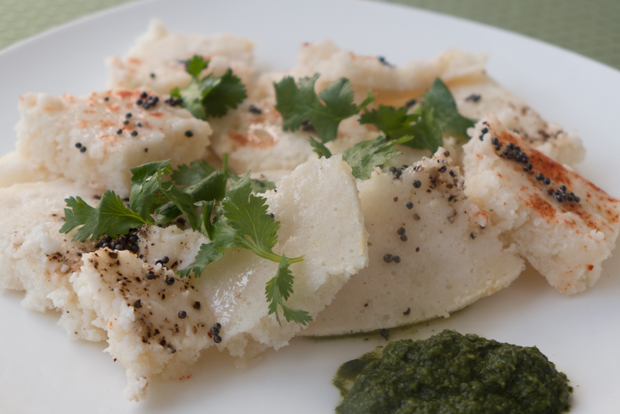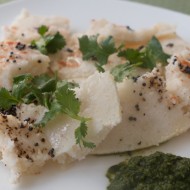Dhokla: Gujarati steamed, fermented rice and lentil cakes

The New York Times ran an entertaining piece the other day on what kids around the world eat for breakfast. While a rather small sample, it gives a good sense of the remarkable variety of foods–from natto (fermented soy beans) to cold cereal–eaten in the morning. There are some commonalities though. In Asia it seems breakfast tends to be savory rather than sweet, and served warm instead of cold, the exact opposite of what one finds in the “west”. Certainly, that is the case in India where a hot breakfast is the norm. It is also highly regional: in the north bread, e.g., as stuffed parathas, is favored, while in the south rice and lentils, in the form of idli for example, rule the roost.
Today’s recipe for dhokla is typical of a Gujarati breakfast from western India, although, like most “breakfast” foods in India, it is also frequently eaten as a snack or at other mealtimes. One thing you’ll notice about Indian breakfast foods is that quick and easy they’re not. To make dhokla batter you first have to soak the rice and lentils for 12 hours, grind them, and then ferment for a day (longer in cold weather). Whew! But that is more than made up for in taste and nutrition, and I’ll take dhokla over cold cereal any day!
Ingredient note: To make fluffy dhokla and other steamed foods such as idli Indian cooks frequently use something called “Eno fruit salt“. This is essentially sodium bicarbonate (baking soda) with a bit of citric acid added. Originally formulated and marketed in the 1850s as an antacid, Eno is now mostly used in India in cooking. Such is Eno’s popularity that it is about as likely to be found in an Indian kitchen as, say, garam masala! In a cinch, you can use baking powder, but Eno is worth seeking out as it has a tart flavor that is ideally suited to savory dishes. You should be able to find it at an Indian grocery store.

Dhokla: Gujarati steamed rice and lentil cakes
Yield: 4 servings
Prep Time: 10 minutes (plus 1-2 days for soaking and fermenting)
Cook Time: 20 minutes
Total Time: 30 minutes (plus 1-2 days for soaking and fermenting)
Ingredients:
- 1 cup basmati rice
- ⅓ cup urad dal
- ½ cup plain yogurt
- ½ tsp salt
- Large pinch ground black pepper
- Large pinch red chile powder
- 2 Tbsp oil (plus more to grease the steamer trays)
- 1 tsp mustard seeds
- 4-5 stalks cilantro, coarsely chopped
- Green chutney for serving
Directions:
- Combine the rice and dal in a large bowl and wash thoroughly. Add enough water to cover and soak for about 10-12 hours.
- Drain and transfer to a blender along with the yogurt and salt. Blitz until you have a smooth batter.
- Pour the batter back into the bowl and cover with plastic wrap. Place it in a warm place to ferment, about 24-48 hours depending on the temperature. When the batter is ready to use you'll see bubbles on the surface and it will taste a bit sour. The batter will keep in the fridge for a few days.
- When ready to cook, get the water boiling in your steamer. Grease the steamer trays with a few drops of oil and ladle enough batter into each tray to make a thin layer (about the width of your pinkie finger). I have 6 inch-diameter trays and typically use about ⅔ cup of batter per tray. Sprinkle ½ tsp Eno onto each tray and mix vigorously. Sprinkle the red chile powder or ground black powder on top, place in steamer and cook, covered, until done, about 7-10 minutes. To test, insert a sharp knife; it should come out clean.
- While the dhokla are steaming heat the 2 Tbsp of oil in a small frying pan over medium. Add the mustard seeds and fry until they start to pop. Set aside.
- When the dhokla are done use a knife to cut them into 2" squares. Remove from the tray using a spatula.
- Spoon some of the oil/mustard seeds on top of the dhokla, garnish with the chopped cilantro and serve with green chutney on the side.
